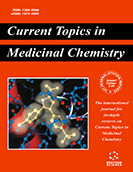Abstract
Chemical investigation of the lichen Cetraria islandica has led to the isolation of four compounds identified as protolichesterinic acid, lichesterinic acid, protocetraric acid and fumarprotocetraric acid. Their structures were characterized using their physical and spectroscopic data. Using an Alamarblue™ 96 well microplate assay, these compounds were tested to evaluate their trypanocidal activity against Trypanosoma brucei brucei. Protolichesterinic acid (MIC = 6.30 µM) and lichesterinic acid (MIC = 12.5 µM) showed very significant activity against the test organism. Docking studies (GRIP technique) of these molecules revealed their strong affinity towards possible targets of Trypanosoma brucei such as riboflavin kinase, sterol-14α-demethylase (CYP51), rohedsain and glutathione synthetase. Hydrophobicity played a significant role in their antitrypanosomal activity.
Keywords: Antitrypanosomal activity, Cetraria islandica, grip docking, iceland moss, phytoconstituents.
Graphical Abstract
Current Topics in Medicinal Chemistry
Title:Antitrypanosomal Activity & Docking Studies of Isolated Constituents from the Lichen Cetraria islandica: Possibly Multifunctional Scaffolds
Volume: 14 Issue: 8
Author(s): John Ogbaji Igoli, Alexander Irvine Gray, Carol Jean Clements, Poorna Kantheti and Rajeev Kumar Singla
Affiliation:
Keywords: Antitrypanosomal activity, Cetraria islandica, grip docking, iceland moss, phytoconstituents.
Abstract: Chemical investigation of the lichen Cetraria islandica has led to the isolation of four compounds identified as protolichesterinic acid, lichesterinic acid, protocetraric acid and fumarprotocetraric acid. Their structures were characterized using their physical and spectroscopic data. Using an Alamarblue™ 96 well microplate assay, these compounds were tested to evaluate their trypanocidal activity against Trypanosoma brucei brucei. Protolichesterinic acid (MIC = 6.30 µM) and lichesterinic acid (MIC = 12.5 µM) showed very significant activity against the test organism. Docking studies (GRIP technique) of these molecules revealed their strong affinity towards possible targets of Trypanosoma brucei such as riboflavin kinase, sterol-14α-demethylase (CYP51), rohedsain and glutathione synthetase. Hydrophobicity played a significant role in their antitrypanosomal activity.
Export Options
About this article
Cite this article as:
Igoli Ogbaji John, Gray Irvine Alexander, Clements Jean Carol, Kantheti Poorna and Singla Kumar Rajeev, Antitrypanosomal Activity & Docking Studies of Isolated Constituents from the Lichen Cetraria islandica: Possibly Multifunctional Scaffolds, Current Topics in Medicinal Chemistry 2014; 14 (8) . https://dx.doi.org/10.2174/1568026614666140324122323
| DOI https://dx.doi.org/10.2174/1568026614666140324122323 |
Print ISSN 1568-0266 |
| Publisher Name Bentham Science Publisher |
Online ISSN 1873-4294 |
 25
25
- Author Guidelines
- Bentham Author Support Services (BASS)
- Graphical Abstracts
- Fabricating and Stating False Information
- Research Misconduct
- Post Publication Discussions and Corrections
- Publishing Ethics and Rectitude
- Increase Visibility of Your Article
- Archiving Policies
- Peer Review Workflow
- Order Your Article Before Print
- Promote Your Article
- Manuscript Transfer Facility
- Editorial Policies
- Allegations from Whistleblowers
- Announcements


























